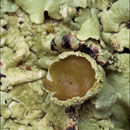Associations
provided by BioImages, the virtual fieldguide, UK
In Great Britain and/or Ireland:
Lichen / symbiont
apothecium of Abrothallus microspermus lives on/in thallus of Flavoparmelia caperata
Lichen / pathogen
clustered pycnidium of Lichenoconium coelomycetous anamorph of Lichenoconium erodens infects and damages bleached or necrosed thallus of Flavoparmelia caperata
Lichen / parasite
pycnidium of Phoma coelomycetous anamorph of Phoma cytospora parasitises pale brownish thallus of Flavoparmelia caperata
Lichen / symbiont
pycnidium of Vouauxiomyces coelomycetous anamorph of Vouauxiomyces truncatus lives on/in Flavoparmelia caperata
Diagnostic Description
provided by Mushroom Observer
UPPER SURFACE: shiny, smooth, greenish, emaculate, flat
LOWER SURFACE: dark brown to black, rhizines becoming v short and sparse near margins
LOBES: rounded, eciliate
SORALIA: granular, circular but becoming confluent in age
CHEMISTRY: cortex K-, KC+y; medulla K-, C-, P+r
- photographer
- Jason Hollinger
Distribution
provided by Mushroom Observer
Worldwide temperate to tropical.
- photographer
- Jason Hollinger
General Description
provided by Mushroom Observer
Broad, greenish, appressed epiphytic foliose lichen. Lobes are smooth, rounded, flat, shiny, with black or grayish pigment usually showing around the margin (from pigmented lower cortex). Apothecia are rare; soralia on raised bumps in center of thallus.
- photographer
- Jason Hollinger
Habitat
provided by Mushroom Observer
On bark of mostly broadleaf trees, fenceposts, occ. rock.
- photographer
- Jason Hollinger
Look Alikes
provided by Mushroom Observer
Flavoparmelia baltimorensis
isidiate-pustulate, rarely appearing sorediate, gen. on rock
Flavopunctelia spp.
white markings on the surface, medulla C+r
Xanthoparmelia spp.
nearly always on rock, rarely sorediate
I’m not sure what the fundamental difference is between Flavoparmelia and Xanthoparmelia. There is little overlap of habitat, but the former can grow on weathered wood and rock. The former is never isidiate, but the latter can rarely be sorediate, and of course both can be fertile. The anatomy of the cortex, the chemistry, and the ascospores and conidia all seem to be the same. Brodo claims rock-dwelling Flavoparmelia are typically broader-lobed and more wrinkly. Also, all Xanthoparmelia I’ve seen are far more abundantly pycnidiate, especially the fertile ones.
- photographer
- Jason Hollinger
Comprehensive Description
provided by Smithsonian Contributions to Botany
Pseudoparmelia caperata
Pseudoparmelia caperata (L.) Hale, 1974:189.
Lichen caperatus L. 1753:1147 [type collection: England, Dillenius, Historia Muscorum 193, specimen represented by pl. 25: fig. 97 (OXF, lectotype)].
Parmelia caperata (L.) Acharius, 1803:216.
Parmelia caperata b. cyliphora Acharius, 1814:196 [type collection: North America, Muhlenberg (H, lectotype; UPS, isolectotype); listed in error as “cylisphora.”]
Parmelia perlata var. flavicans Tuckerman, 1866:13 [type collection: California, Bolander 70 (FH-Tuck, holotype)].
Parmelia euplecta Stirton, 1877–78:299 [type collection: Brisbane, Australia, Bailey (BM, lectotype)].
Parmelia flavicans (Tuckerman) Tuckerman, 1882:53 [not P. flavicans (Swartz) Acharius, 1803:268 (= Teloschistes)].
Parmelia ochroleuca f. sorediosa Müller Argoviensis, 1883b: 77 [type collection: Mt. Dromedary, Australia, Reader (G, lectotype)].
Parmelia subglauca Nylander in Gasilien, 1894:126 [type collection: Saint Omer, France (H, lectotype: BM, PC isotypes)].
Parmelia cylisphora [sic] (Acharius) Vainio, 1896b:7.
Parmelia caperata var. subglauca (Nylander in Gasilien) Nylander, 1896:35.
Parmelia caperata f. laevissima Gyelnik, 1928:587 [type collection: Meleghegy, Fehér, Hungary, Gyelnik (BP, holotype)].
Parmelia herreana Zahlbruckner, 1929:239 [based on P. flavicans (Tuckerman) Tuckerman].
Parmelia pseudosorediosa Gyelnik, 1931b:288 [based on Parmelia ochroleuca f. sorediosa Müller Argoviensis].
Parmelia negativa Gyelnik 1934:301 [type collection: Salisbury Cove, Maine, Plitt (BP, holotype)].
Pseudoparmelia euplecta (Stirton) Hale, 1974:190.
Pseudoparmelia pseudosorediosa (Gyelnik) Hale, 1974:190.
DESCRIPTION.—Thallus adnate to loosely attached, growing on bark or more rarely on rocks, yellowish green, 5–20 cm in diameter, coalescing to form larger colonies; lobes subirregular, apically rotund, 3–8 mm wide; upper surface plane to undulate or rugulose, continuous, sorediate, the soralia laminal, diffuse and coalescing; medulla rarely orange near the lower cortex; lower surface black, moderately to sparsely rhizinate except for a naked brown rugose zone along the margins. Apothecia very rare, 2–5 mm in diameter; spores 8, 8–13 × 17–24 m.
CHEMISTRY.—Cortex K−, medulla K−, C−, KC+ rose, P+ red, atranorin, caperatic, protocetraric, and usnic acids; if pigmented, skyrin present.
DISTRIBUTION.—Pantemperate on all major continents (Figure 8).
HABITAT.—On conifers and deciduous trees in temperate forests, common on rocks only at the northern part of its range, from sea level to over 3000 m elevation.
- bibliographic citation
- Hale, Mason E., Jr. 1976. "A Monograph of the Lichen Genus Pseudoparmelia Lynge (Parmeliaceae)." Smithsonian Contributions to Botany. 1-62. https://doi.org/10.5479/si.0081024X.31
Flavoparmelia caperata: Brief Summary
provided by wikipedia EN
Flavoparmelia caperata, the common greenshield lichen, is a foliose lichen that grows on the bark of trees, and occasionally on rock.
- license
- cc-by-sa-3.0
- copyright
- Wikipedia authors and editors

